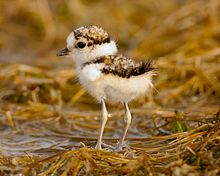Little ringed plover
| Little ringed plover | |
|---|---|

| |
| C. d. jerdoni from Mangaon, Maharashtra, India | |
| Scientific classification | |
| Domain: | Eukaryota |
| Kingdom: | Animalia |
| Phylum: | Chordata |
| Class: | Aves |
| Order: | Charadriiformes |
| Family: | Charadriidae |
| Genus: | Charadrius |
| Species: | C. dubius
|
| Binomial name | |
| Charadrius dubius Scopoli, 1786
| |
The little ringed plover (Charadrius dubius) is a small plover. The genus name Charadrius is a Late Latin word for a yellowish bird mentioned in the fourth-century Vulgate. It derives from Ancient Greek kharadrios a bird found in river valleys (kharadra, "ravine"). The specific dubius is Latin for doubtful, since Sonnerat, writing in 1776, thought this bird might be just a variant of common ringed plover.[2]
Description


Adults have a grey-brown back and wings, a white belly and a white breast with one black neckband. They have a brown cap, a white forehead, a black mask around the eyes with white above and a short dark bill. The legs are flesh-coloured and the toes are all webbed.
This species differs from the larger ringed plover in leg colour, the head pattern, and the presence of a clear yellow eye-ring.



Habitats and range
Their breeding habitat is open gravel areas near freshwater, including gravel pits, islands and river edges in Eurasia and northwestern Africa. They nest on the ground on stones with little or no plant growth. Both males and females take turns incubating the eggs.
They are migratory and winter in Africa. These birds forage for food on muddy areas, usually by sight. They eat insects and worms.
Subspecies
Three subspecies recognized.
- C. d. curonicus J. F. Gmelin, 1789 - from Eurasia, Russian Fareast, Japan, Korea, China to North Africa. Winter spends in Sahara, Sri Lanka, to Indonesia and China.
- C. d. jerdoni (Legge, 1880) - from India, Sri Lanka, Pakistan to South East Asia.
- C. d. dubius Scopoli, 1786 - from the Philippines, New Guinea to Bismarck Archipelago.
Conservation
The little ringed plover is one of the species to which the Agreement on the Conservation of African-Eurasian Migratory Waterbirds (AEWA) applies.
References
- ^ Template:IUCN
- ^ Jobling, James A (2010). The Helm Dictionary of Scientific Bird Names. London: Christopher Helm. pp. 99, 141. ISBN 978-1-4081-2501-4.
External links
- Little ringed plover Images and documentation
- Sexing and ageing (PDF; 5.4 MB) by Javier Blasco-Zumeta & Gerd-Michael Heinze
- BirdLife species factsheet for Charadrius dubius
- "Charadrius dubius". Avibase.
- "Little ringed plover media". Internet Bird Collection.
- Little ringed plover photo gallery at VIREO (Drexel University)
- Interactive range map of Charadrius dubius at IUCN Red List maps
- Audio recordings of Little ringed plover on Xeno-canto.
- Charadrius dubius in Field Guide: Birds of the World on Flickr
- Little ringed plover media from ARKive


